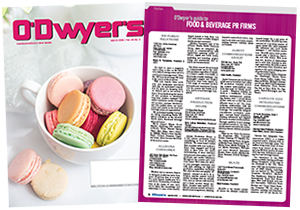|
|
A few established companies, such as Newman’s Own and Ben & Jerry’s, have built their names and business models on what can be considered humanitarian marketing. Although additional brands are now capitalizing on this business model — such as Aquaball, which campaigns against diabetes in kids — and many garner successful responses among consumers, this is still a largely underserved niche with a considerably untapped market.
|
|
In an age where consumers are becoming increasingly health conscious and environmentally aware, food and beverage companies associated with poor environmental standards or whose products are seen as damaging — sugar, fat, chemicals — are shifting their publicly efforts. We will see more brands moving toward presenting new products, or remaking old ones, integrating philanthropy and the greater good to create social capital.
Giving charity or even time to socially conscious ideals can often be difficult, so consumers seek out socially conscious products to help them fill the need. When they use their money to purchase socially conscious products, making a brand’s social purpose a major factor in their decisions, the consumer feels as if he has given back as well.
It’s brilliant in a way: the company sells more products and makes money, while consumers feel rewarded thinking they have, in some way, helped save the rainforest by doing little more than spending money on a product they would have likely bought anyway. It’s a win-win.
For instance, responsibly grown Thanksgiving Coffee’s slogan is, “Not just a cup but a just cup,” stating on the label that it supports “social equity” through fair trade practices. It advertises that its coffee beans are shade grown, environmentally conscious, and high-end. Despite a higher price point than other coffee, consumers pay more to give back and help local and small farmers.
Today, it is not enough to simply offer a product, no matter how good. There are many more choices on crowded supermarket shelves, and a brand has to do something to differentiate itself from the crowd. Millennials ask why they should support a brand — they want to feel involved, and that is a key component of cause marketing today. What feeling does your product give a customer? If it is something positive and uplifting, consumers will feel better about buying it rather than from a competitor, even if it costs a little more. Whole Foods has mastered this model, and people gladly pay more to feel they are making a difference.
The popularity of Whole Foods is based largely on self-esteem. People shop there because they want to feel good about themselves for buying food products they see as being healthy for them and their kids, ethical for small food manufacturers and good for the environment. Shopping at Whole Foods is more expensive than most grocery stores, but its consumers willingly flock there, and now traditional supermarkets are adopting organic and fair trade products to recapture market share.
Promoting the greater good puts you ahead of the competition by making people think you care, and inversely, that your competitors do not. Gluten-free, fat free or zero sugar food and drinks can make an otherwise indulgent food seem like the moral choice. “After all, it’s for a good cause,” the consumer thinks. Making people feel good about the choices they make as consumers can increase sales and build strong customer loyalty.
After necessity, emotion is the prime motivator in purchase decisions. Consumers buy products because they support their sense of identity, their place in our culture, because the products appeal to their aspirations or boost their sense of self-worth. The initial success of Toyota’s Prius proves that, with environmentally conscious drivers flocking to the homely looking, lackluster performance hybrid.
Giants such as Coca-Cola and Pepsi have taken the challenges of the socially conscious movement as an opportunity to reach new markets and shift consumer focus to their products. Coca-Cola’s recycling initiative encourages consumers to enjoy a coke and recycle. It has also made market innovations with the “healthier” alternative soda, Coca-Cola Life, packaged in a subliminally green can, and sweetened with the new go-to sugar substitute Stevia instead of high fructose corn syrup — yielding about 85 calories (half that of Coke Classic).
In 2014, Pepsi got on the social cause bandwagon when it released Pepsi True, a healthier alternative to regular Pepsi. By eliminating high fructose corn syrup and replacing it with a sugar-stevia blend, and also using green color-coded packaging, it entered the new market for mid-calorie carbonated beverages, and became a viable competitor to Coke Life.
But food and drink manufacturers should be careful to support their claims, as Cadbury Schweppes learned. 7UP was being marketed as “Now 100% natural.” The product’s continued use of high fructose corn syrup as an ingredient, however, resulted in outrage. Opponents to the new marketing raised issue with the fact that the commonly used sugary substance is a chemically corn byproduct. The company instead decided to advertise only the natural ingredients, marketing it only as “healthier.” Social media caused that. In our 24/7 Internet media environment, people are waiting for the opportunity to call out perceived evils. Nothing is worse for brand image than being labeled as deceptive.
Innovating with socially positive efforts for a brand is something that consumers, public affairs websites and social media latch on to, and has potential to spread virally. Media love uplifting stories about companies contributing to bettering the world. When done effectively, it can focus the public’s attention from a company that be may viewed with some trepidation due to past practices, to where it’s considered a socially conscious brand to be respected.
* * *
Ronn Torossian is the CEO & Founder of 5W Public Relations. 5WPR is headquartered in NYC with offices in Los Angeles and Denver.




 What the biggest meal of the day can teach us about serving up effective nutrition communications campaigns.
What the biggest meal of the day can teach us about serving up effective nutrition communications campaigns. Tips to refine and amplify your CPG brand strategy to win in 2024 and beyond.
Tips to refine and amplify your CPG brand strategy to win in 2024 and beyond. Strategic communications strategies for success in the growing “food is medicine” movement.
Strategic communications strategies for success in the growing “food is medicine” movement. How brands can authentically communicate sustainability issues and create a brand experience that’s compatible with consumers’ values.
How brands can authentically communicate sustainability issues and create a brand experience that’s compatible with consumers’ values. Communicating the effects that climate change and a growing world population have on our food system—and why change is needed.
Communicating the effects that climate change and a growing world population have on our food system—and why change is needed.


 Have a comment? Send it to
Have a comment? Send it to 
No comments have been submitted for this story yet.